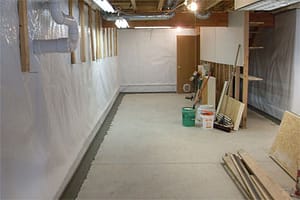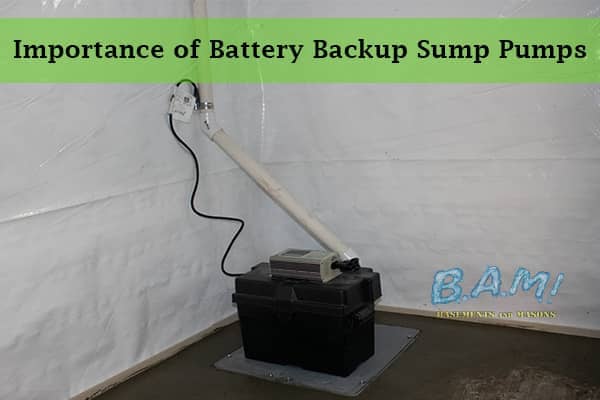Best Basement Waterproofing for Beginners
The Facts About Best Basement Waterproofing Revealed
Table of Contents5 Easy Facts About Best Basement Waterproofing ShownThe Only Guide to Best Basement WaterproofingThe 2-Minute Rule for Best Basement WaterproofingThe Main Principles Of Best Basement Waterproofing An Unbiased View of Best Basement Waterproofing
AdvantaClean's skilled experts and specialists will locate the water source. If wall or slab splits are existing, we will infuse polyurethane and epoxies right into the splits and secure the compromise, protecting against further moisture from getting in.
If there's condensation outside of the aluminum foil, you have high humidity in your basement. Fix it with a portable space dehumidifier or a whole-house humidifier system as opposed to waterproofing products. If the foil has condensation on the inside surface (alongside the wall surface), the soil around your house may be normally damp from a high water table or poor dirt water drainage.
You can waterproof simply your interior wall surfaces, which may fix the trouble. Once they dry, they adhere permanently to concrete and masonry walls.
Best Basement Waterproofing Fundamentals Explained
Concrete waterproof finishings can not be applied to formerly repainted surface areas; examine the tag. Known as densifiers, they are ideal only for wall surfaces that have not been painted or secured.
You clean, roll, or spray it on much even more heavily one gallon covers just 75 square feet, not the 300 square feet typical with standard paint. Waterproof paint is fine for DIY application. You can use it over painted surfaces, and paint over it once it's cured (one gallon expenses $37).
It can cost $10,000 to $15,000, relying on the work needed. Outside waterproofing involves excavating throughout your house fully depth of the structure walls, after that mounting a waterproof covering or membrane layer covered by drainage panels. The panels offer a very easy path for water to flow to an outside French drainpipe at the base of your structure.
A cellar without waterproofing is kind of like that. Your basement doesn't want to go through a downpour without appropriate defense just as much as you do not desire to.
All About Best Basement Waterproofing
If you've done your research study, you 'd know there are two types of waterproofing: inside and outside. It can obtain puzzling what they both mean, which one's a much better financial investment, and what will really keep the water out. Don't worry, we put together this blog to easily specify both approaches for you and discuss the pros and cons of each.
Outside waterproofing is a waterproofing technique that entails securing your home from the outside. The structure straight from the source wall surfaces are then cleansed, sealed, and covered with a water-proof membrane or sealant.

Indicators on Best Basement Waterproofing You Should Know
It's a more involved procedure that requires digging up your yard, which is pricey and lengthy. Exterior waterproofing includes eliminating every this article little thing surrounding your house, including patios, driveways, sidewalks, landscaping, AC units, decks, and so on. If any one of the job was done improperly and water is still entering your cellar, there isn't much you can do to fix or fix it.
Inside cellar waterproofing includes waterproofing from the inside. Any water that leakages into your cellar is rerouted before it touches your flooring. It's sort of like wearing a raincoat under your clothing. It entails 2 things: a water drainage track and a sump pump. It works by sealing the within your basement walls and floorings so water that tries to get in is channeled out via a sump pump.
It's an effective method to water resistant your basement - Best Basement Waterproofing. The drawback of indoor basement waterproofing primarily has to do with the installment process. This method calls for saved things, furniture, and built-in shelving or cabinets to be relocated from touching the basement wall surfaces. And throughout setup, your cellar can not be utilized. The biggest difference in between the 2 methods is this: Outside waterproofing is a preventative solution and indoor waterproofing is a rehabilitative remedy.
All about Best Basement Waterproofing
Finally, outside and interior cellar waterproofing are both reliable methods of protecting your home from water damage. Outside waterproofing develops an obstacle that prevents water from entering your great site home, while interior waterproofing reroutes water that does enter your home. And it is very important to keep in mind that exterior waterproofing is a pricey and disruptive installment process when contrasted to indoor waterproofing.
Whichever technique you choose, make sure you select a trusted and credible service provider for the job. If you have any kind of questions regarding cellar waterproofing, please get to out to us.
You can fill in our form right here, start a conversation in the lower right-hand corner, or call us at 1-800-827-0702.